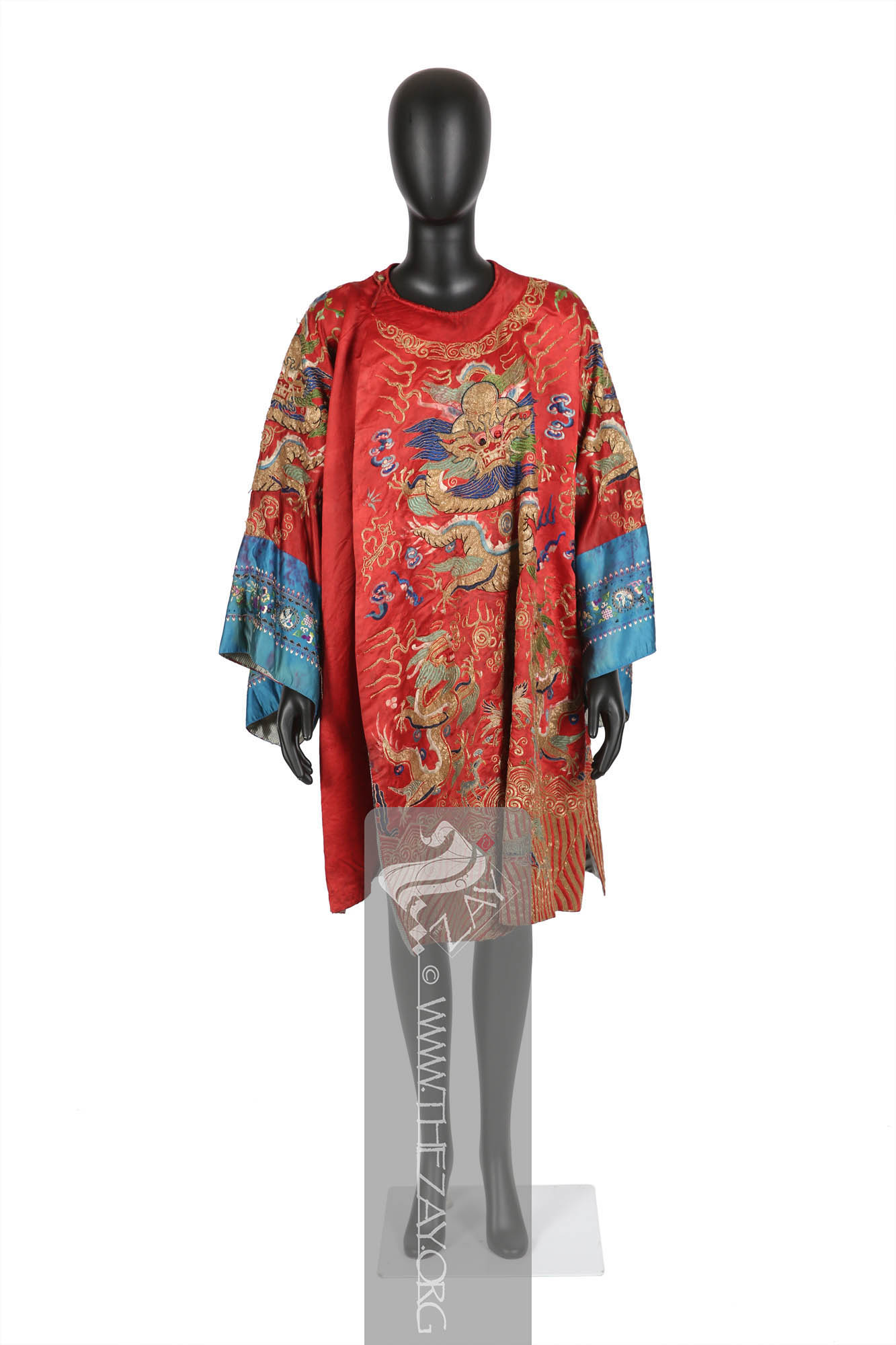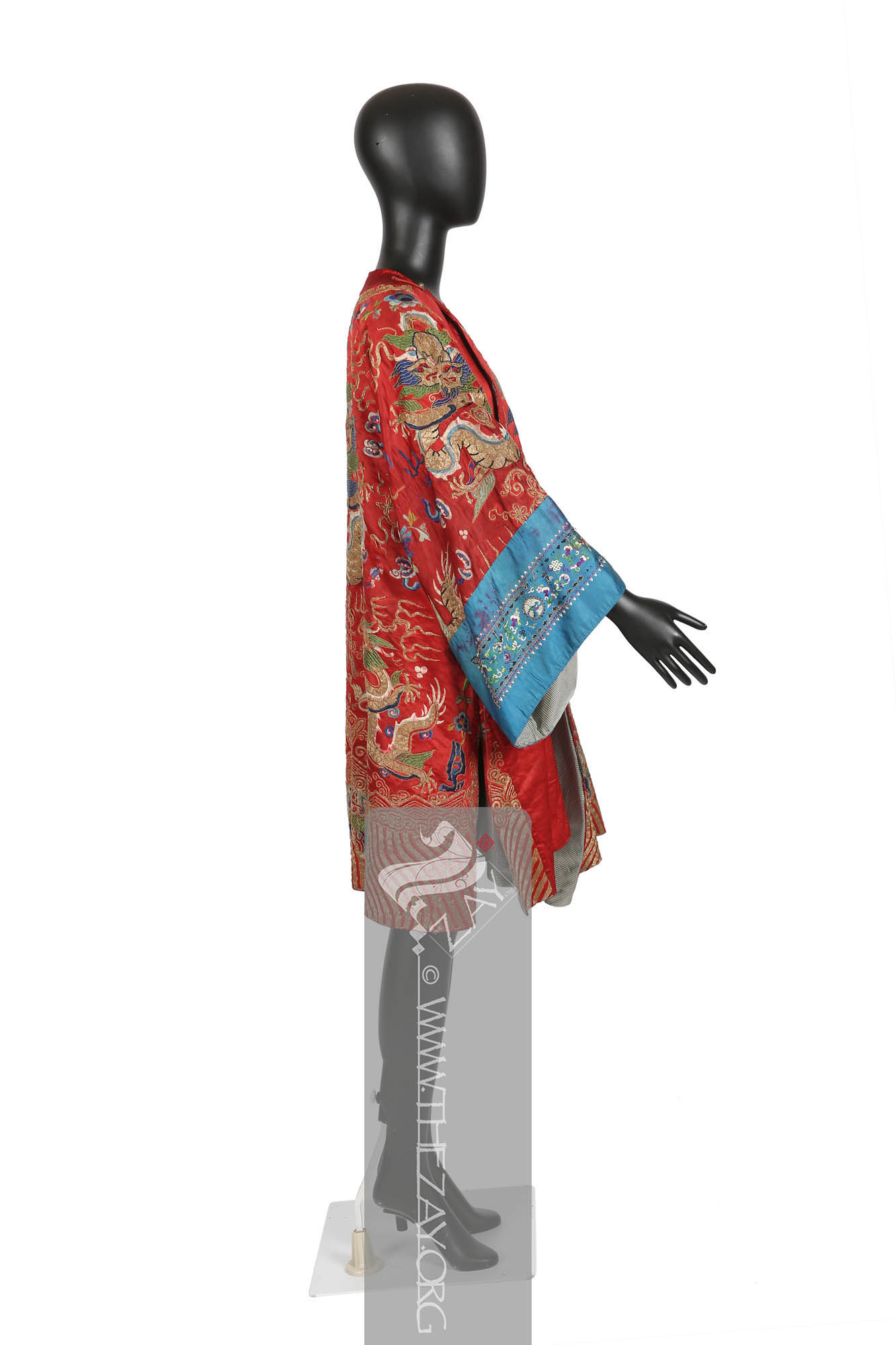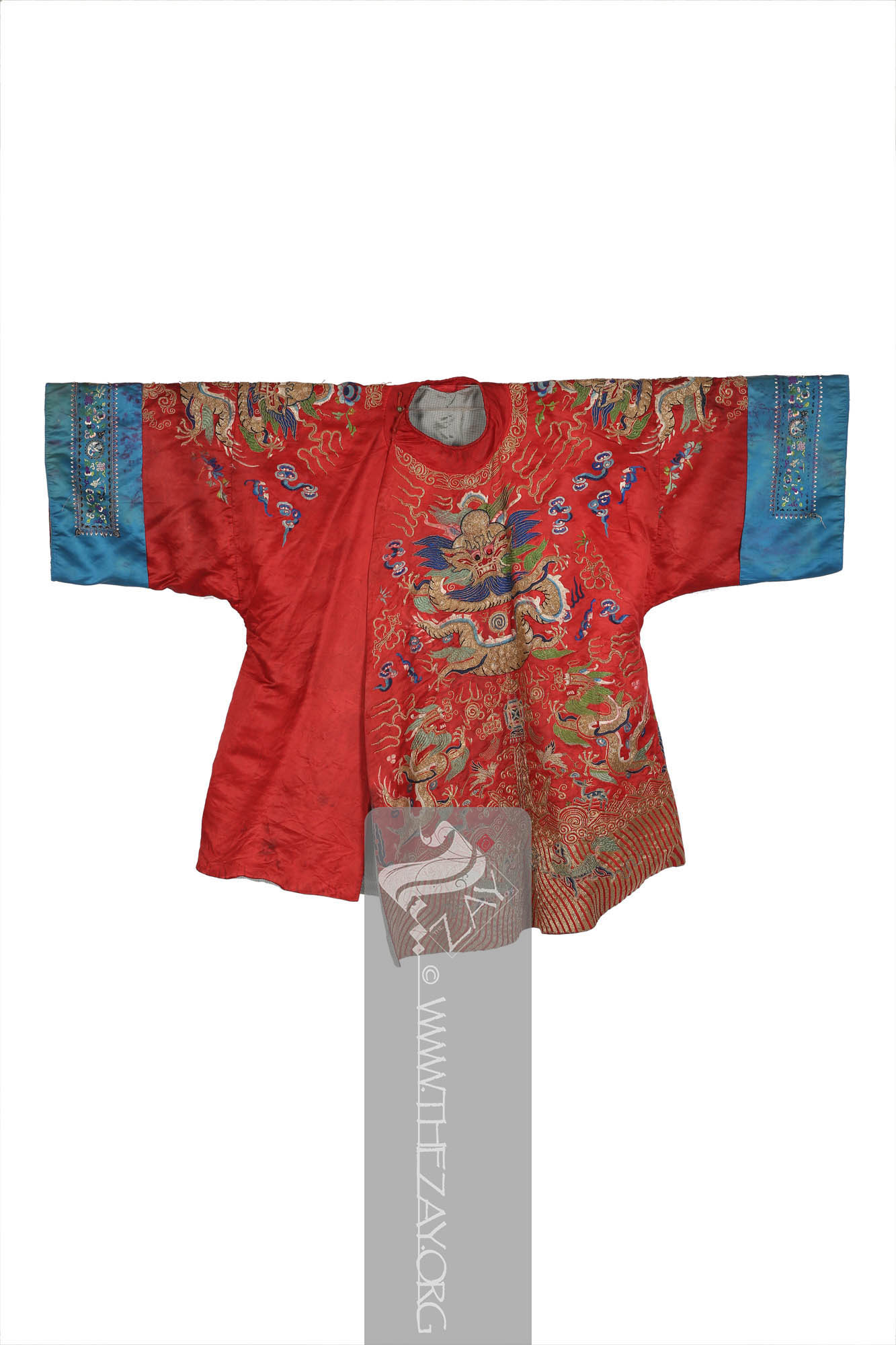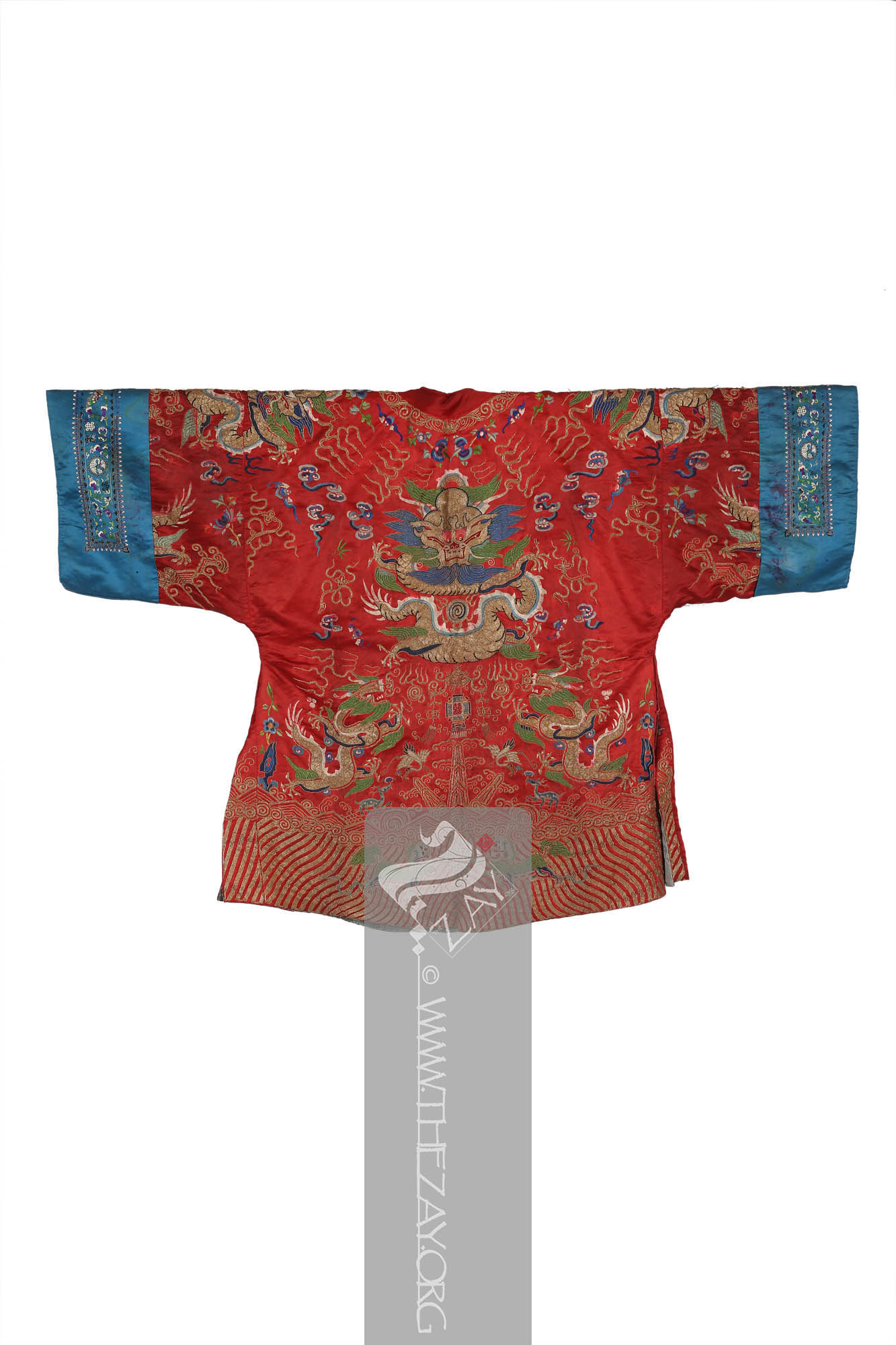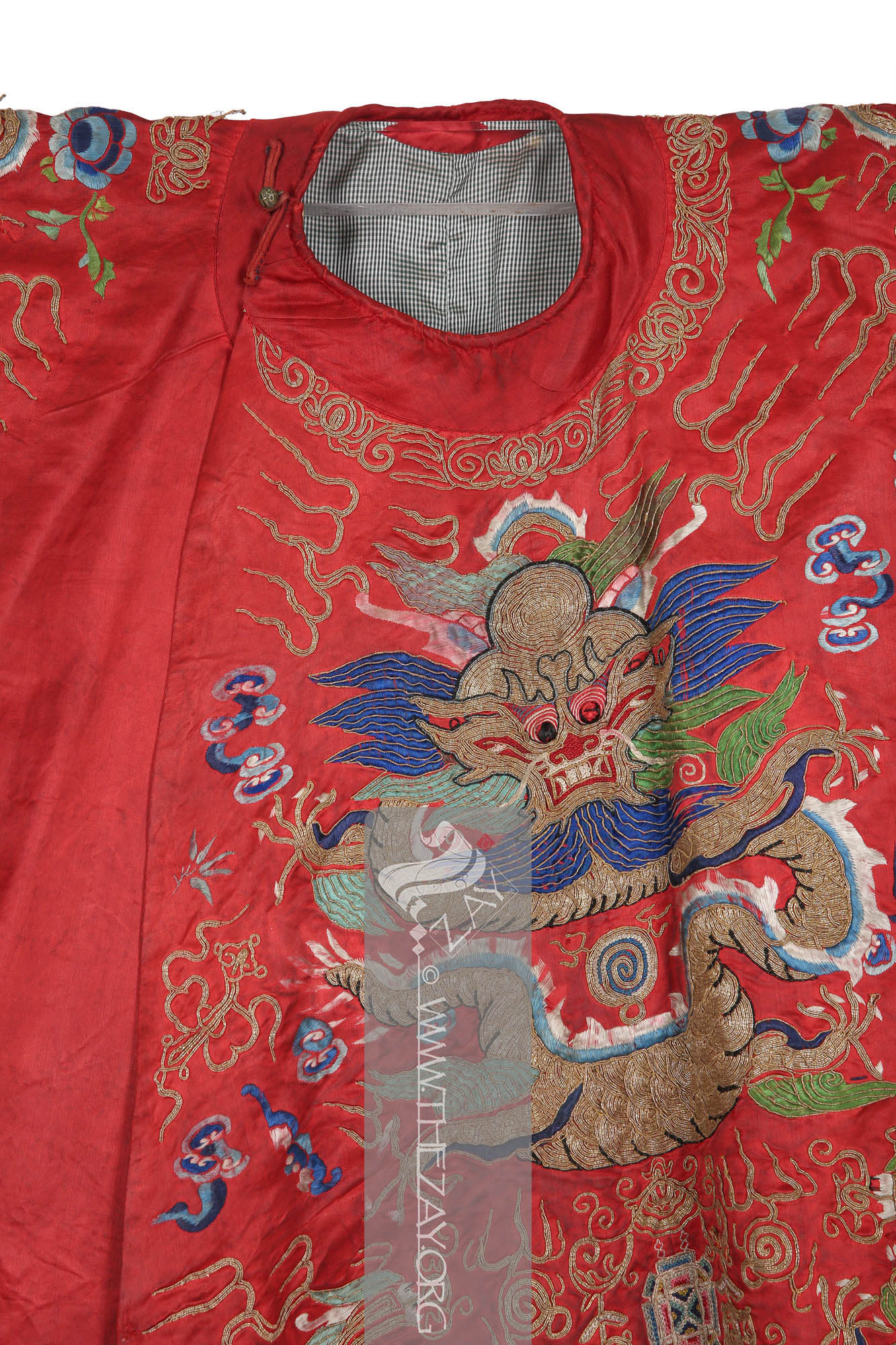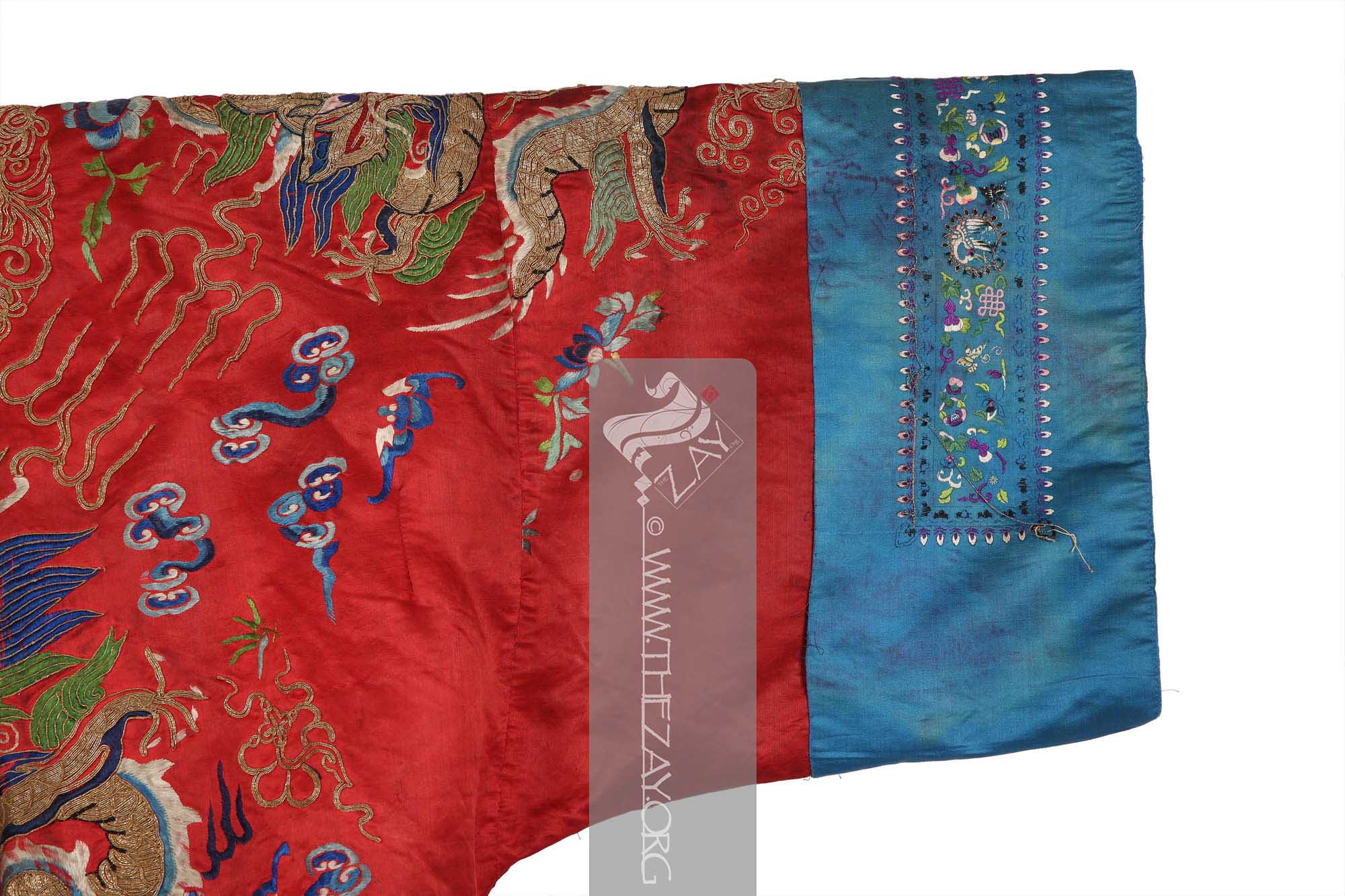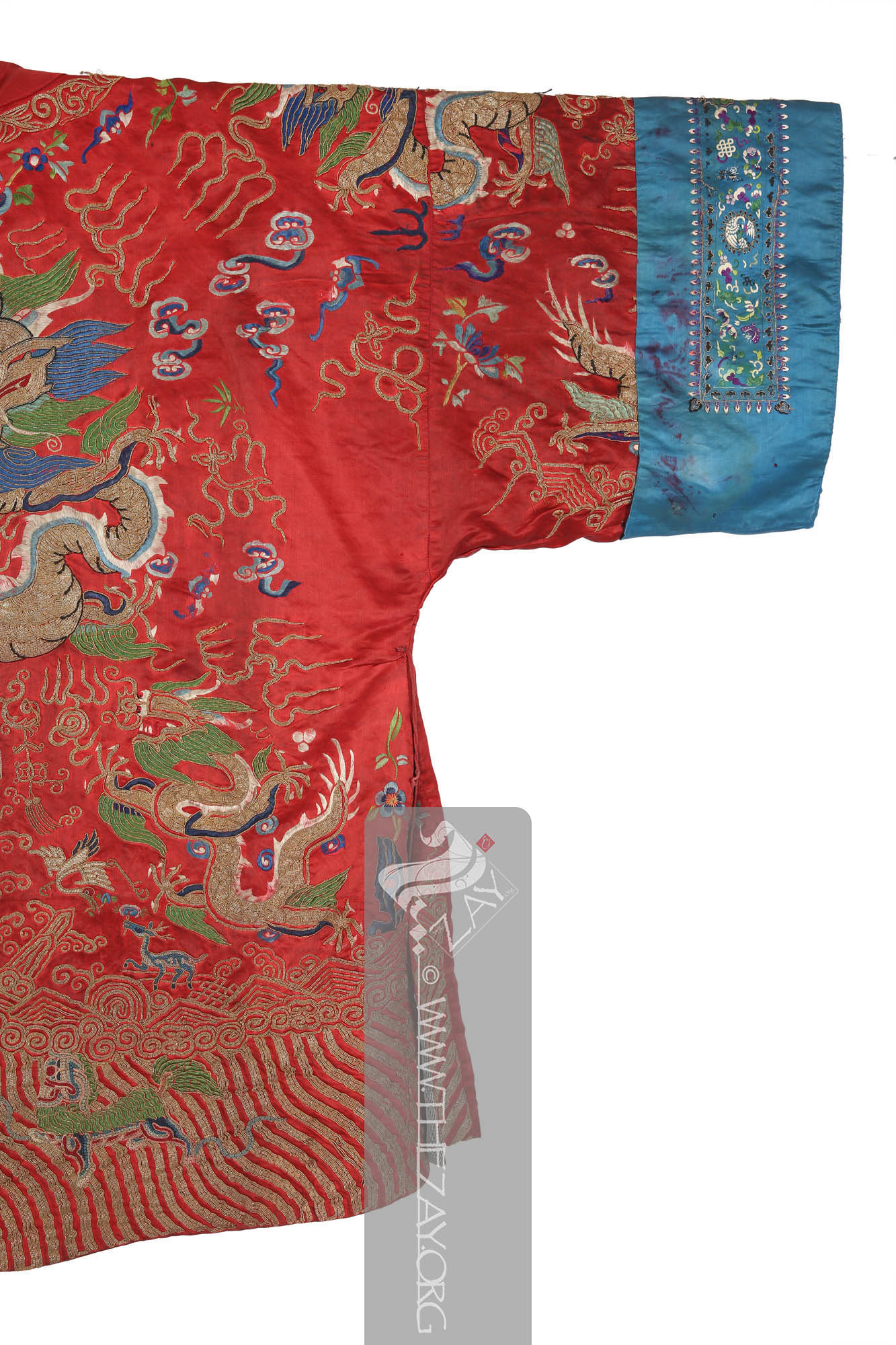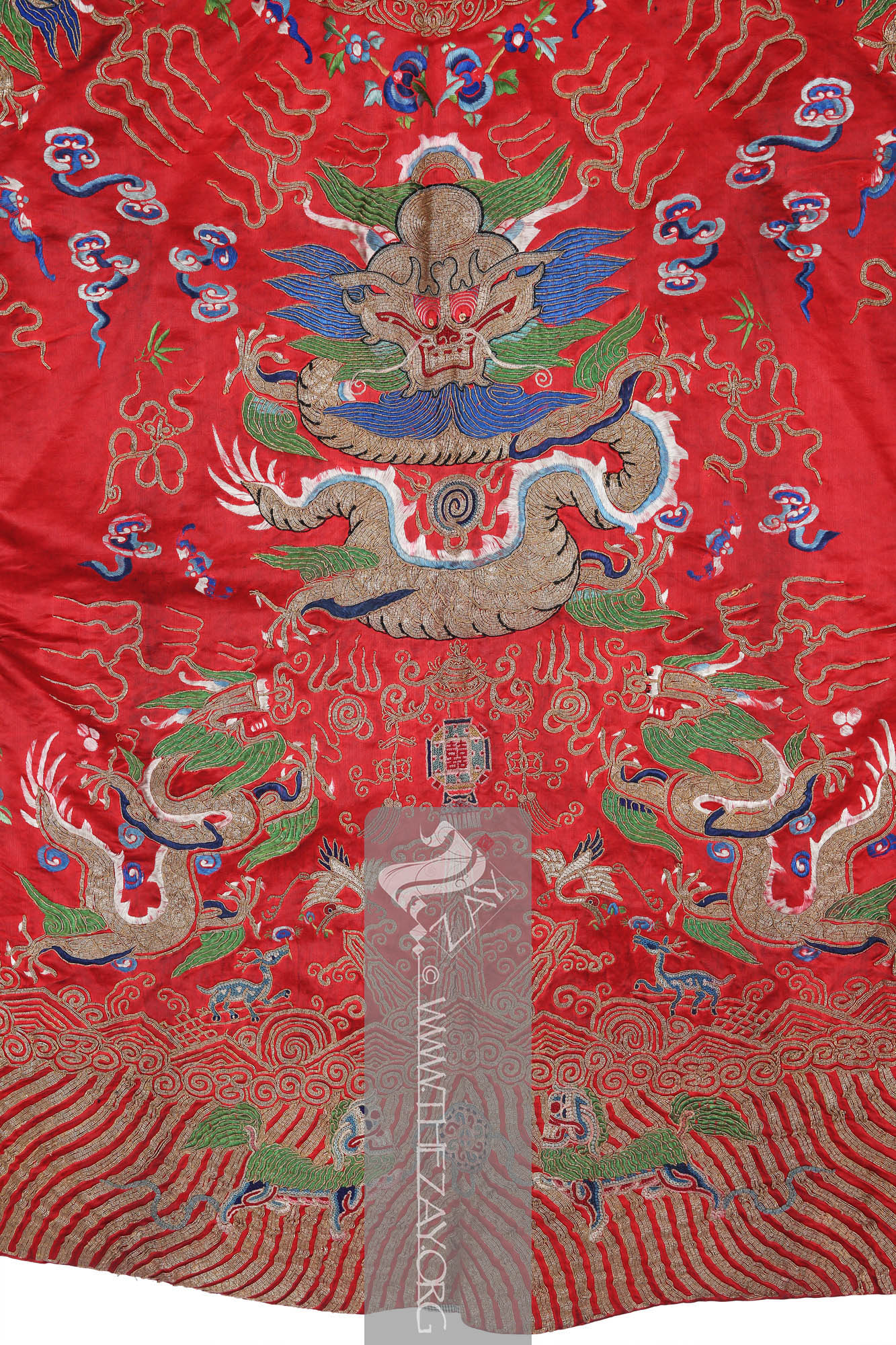Object HistoryThis vibrant silk women’s dragon robe of (
satin
Sātin: (Arabic: Zaytuni: from Chinese port of Zayton in Quanzhou province where it was exported from and acquired by Arab merchants), one of the three basic types of woven fabric with a glossy top surface and a dull back. Originated in China and was fundamentally woven in silk.) weave was purchased by Dr. Reem El Mutwalli from a dealer in London in 2015 to add to the collection of the
Zay
Zay: (Arabic: costume, Pl. azyaā’), a set of clothes in a style typical of a particular country or historical period. Initiative.
Object FeaturesThis is a scarlet red women’s silk dragon robe (
jifu_longpao
Jifu_longpao: (Chinese: jifu – Auspicious dress; longpao – Dragon robe, synonyms: manfu, Manchu clothing); is a traditional semi formal Chinese court robes for festive occasions worn by both men and women during joyful celebrations, banquets, and ceremonies easily identified by their five clawed dragon patterns and were limited to members of the royal family. ) in (
satin
Sātin: (Arabic: Zaytuni: from Chinese port of Zayton in Quanzhou province where it was exported from and acquired by Arab merchants), one of the three basic types of woven fabric with a glossy top surface and a dull back. Originated in China and was fundamentally woven in silk.) weave embellished with (
satin_stitch
Satin_stitch: (Synonym: Damask Stitch), is a type of flat embroidery stitch that creates a satin like smooth and shiny surface by closely spaced stitches, covering an entire area or shape.), (
Peiking_knot
Peiking_knot: (Chinese: Peiking – old name of Beijing capital of China; Synonym – Chinese_knot), is a Chinese traditional knotted embroidery technique that involves creating raised, textured designs using small, tight knots. It originated in the Ming Dynasty and was popularized in the Qing Dynasty. ), and (
couching
Couching: (Latin: collocare – Place together), in needlework and embroidery couching is a technique in which yarn or other materials are laid across the surface of the ground fabric and fastened in place with small stitches of the same or a different yarn
) style embroideries executed by hand. It is a loose robe with straight loose sleeves and a (
lishui
Lishui: (Chinese: lishui – standing water) or (stripes), is a set of multicoloured diagonal lines either straight or wavy running parallel to each other forming a pattern that depicts calm sea waves. ) hem on the fall with a closed round neckline and a (
frog_fastener
Frog_fastener: (Synonym: Chinese frog closure, frog closure), is a decorative and functional type of button used to fasten clothing. Said to have originated between c. 5th to 7th century China these buttons consist of a cord or braid looped through a decorative knot.
) style button with a round metal – gold/brass – ball button.
The field of the robe is woven in scarlet red
satin
Sātin: (Arabic: Zaytuni: from Chinese port of Zayton in Quanzhou province where it was exported from and acquired by Arab merchants), one of the three basic types of woven fabric with a glossy top surface and a dull back. Originated in China and was fundamentally woven in silk. and is embellished with three golden dragon figures. Each dragon displays five claws on their paws and is executed through
couching
Couching: (Latin: collocare – Place together), in needlework and embroidery couching is a technique in which yarn or other materials are laid across the surface of the ground fabric and fastened in place with small stitches of the same or a different yarn
style embroidery with metal – gold/copper – threads that were beaten and flattened into thin foils for malleability. Apart from the metal threads, there is extensive use of dark and (
turquoise
Turquoise: (French: turquois – present day Türkiye; Synonyms: firuze, pheroza), is a naturally occurring opaque mineral mined in abundance in Khorasan province of Iran and has been used for making dye for centuries. The term is a derivative of the French word for the country Türkiye once called Turkey. ) blue, green in light and jade shades as well as red and black silk
floss
Floss: (Old French: flosche – nap of velvet), is a type of silk fibre obtained from the cocoons of wild silkworms. It is characterized by its long, fluffy fibers that are not tightly woven, making it ideal for use in various textile applications such as embroidery, lace-making, and sewing. threads.
Parts of the dragon’s face are constructed with
Peiking_knot
Peiking_knot: (Chinese: Peiking – old name of Beijing capital of China; Synonym – Chinese_knot), is a Chinese traditional knotted embroidery technique that involves creating raised, textured designs using small, tight knots. It originated in the Ming Dynasty and was popularized in the Qing Dynasty. embroidery. There are two dragons displayed on the two shoulders and three more at the back mirroring the front. The four dragons – two on the shoulders and two beneath the neckline - signify four cardinal directions.
It is worth noting that the five claws on each paw of the dragon are a nod towards the royal family. Strict sumptuary laws from the ancient times up until the Qing period (1644-1912) limited the use of the colour yellow on robes and garments to the emperor and the primary members of the royal family like the empress dowager, the crown prince, and may be the primary imperial consort. A blush red or an apricot orange colour robe like this was mostly reserved for the consorts of the crown prince. However, these sumptuary regulations were not always strictly adhered to by the end of the Qing rule in the early 20th century.
The dragons are depicted swirling and soaring in their celestial abode with auspicious rolling clouds – depicted in shades of blue and grey – flaming pearls and flames – also depicted with
couching
Couching: (Latin: collocare – Place together), in needlework and embroidery couching is a technique in which yarn or other materials are laid across the surface of the ground fabric and fastened in place with small stitches of the same or a different yarn
embroidery in metal threads. This kind of five-clawed golden dragon robe was reserved for the empress or lower-ranking imperial consorts.
Beneath the dragon figures the hem of the robe is embellished with
lishui
Lishui: (Chinese: lishui – standing water) or (stripes), is a set of multicoloured diagonal lines either straight or wavy running parallel to each other forming a pattern that depicts calm sea waves. stripes signifying calm or standing waters and emerging from it the rock-like shapes or mountain peaks symbolises the isle of the immortals. But interestingly, unlike other
lishui
Lishui: (Chinese: lishui – standing water) or (stripes), is a set of multicoloured diagonal lines either straight or wavy running parallel to each other forming a pattern that depicts calm sea waves. hems which usually were constructed of colourful silk
floss
Floss: (Old French: flosche – nap of velvet), is a type of silk fibre obtained from the cocoons of wild silkworms. It is characterized by its long, fluffy fibers that are not tightly woven, making it ideal for use in various textile applications such as embroidery, lace-making, and sewing. threads the hem of this robe has been executed with
couching
Couching: (Latin: collocare – Place together), in needlework and embroidery couching is a technique in which yarn or other materials are laid across the surface of the ground fabric and fastened in place with small stitches of the same or a different yarn
embroidery in metal threads.
It is also worth noting that while most similar hems usually had nothing more on it apart from the ones on the imperial robes meant for the emperor, dowager empress and the empress or the emperor’s primary consort, this robe depicts two mythical sea creatures shaped almost like horses facing one another embroidered in green silk
floss
Floss: (Old French: flosche – nap of velvet), is a type of silk fibre obtained from the cocoons of wild silkworms. It is characterized by its long, fluffy fibers that are not tightly woven, making it ideal for use in various textile applications such as embroidery, lace-making, and sewing. threads in the middle of the waves.
The neckline of the robe is also embellished with metal thread
couching
Couching: (Latin: collocare – Place together), in needlework and embroidery couching is a technique in which yarn or other materials are laid across the surface of the ground fabric and fastened in place with small stitches of the same or a different yarn
embroidery depicting floral motifs. The sleeves are loose and have thick blue
satin
Sātin: (Arabic: Zaytuni: from Chinese port of Zayton in Quanzhou province where it was exported from and acquired by Arab merchants), one of the three basic types of woven fabric with a glossy top surface and a dull back. Originated in China and was fundamentally woven in silk. bands with thin panels depicting a series of symbolic motifs like butterflies and bats for happiness, pan chang or the “endless knot” signifying a long and continuous life, lotuses for purity, and cranes. It is executed with
satin_stitch
Satin_stitch: (Synonym: Damask Stitch), is a type of flat embroidery stitch that creates a satin like smooth and shiny surface by closely spaced stitches, covering an entire area or shape. embroidery in a variety of colourful silk
floss
Floss: (Old French: flosche – nap of velvet), is a type of silk fibre obtained from the cocoons of wild silkworms. It is characterized by its long, fluffy fibers that are not tightly woven, making it ideal for use in various textile applications such as embroidery, lace-making, and sewing. threads.
Links
- https://digitalcommons.unl.edu/cgi/viewcontent.cgi?article=1106&context=tsaconf
- https://www.youtube.com/watch?v=KrXWXKoq2GY
- https://www.youtube.com/watch?v=Ef28p8MtMaU
- https://www.youtube.com/watch?v=TWfu_mWNnUY
- https://www.youtube.com/watch?v=CPvzuVOYEsE
- https://www.youtube.com/watch?v=zdBeGFHxmAc
- https://www.needlework-tips-and-techniques.com/cutwork
Cutwork: It is a surface embroidery technique using two main stitches – the running stitch and the buttonhole stitch and is usually made on fine linen or cotton with threads that match the fabric colour. It creates a lace like pattern while the stitches prevent the fabric from fraying. -embroidery.html
- https://www.christies.com/features/Chinese-robes-collecting-guide-7813-1.aspx
- https://www.christies.com/en/lot/lot-6130068
- https://onlineonly.christies.com/s/art-asia/blue-ground-kesi
Kesi: (Chinese: kesi – cut silk), a weaving technique in Chinese silk tapestry
Tapestry: wall hanging or other large piece of fabric that is woven in coloured weft
Weft: one of the two basic components used in weaving that transforms thread or yarns into a piece of fabric. It is the crosswise thread on a loom that is passed over and under the warp threads. threads or embroidered with a decorative design. Typically made of wool, but they can also be made of other materials such as silk, linen, or cotton. Often used to decorate homes, churches, and other buildings. using short length weft
Weft: one of the two basic components used in weaving that transforms thread or yarns into a piece of fabric. It is the crosswise thread on a loom that is passed over and under the warp threads. threads with each colour using a separate bobbin. The threads are tucked into the textile in such a way that only the weft
Weft: one of the two basic components used in weaving that transforms thread or yarns into a piece of fabric. It is the crosswise thread on a loom that is passed over and under the warp threads. threads are visible in the finished fabric. -surcoat
Surcoat: (Old French: sur – over), is a loose robe or outer coat that could sometimes be worn over an armour and is worn as a part of an insignia of an order of imperial guards or a knighthood. -longgua-655/156157
- https://exchange.umma.umich.edu/resources/26228#
- https://www.ngv.vic.gov.au/wpcontent/uploads/2020/07/Sheet7_AsianEduRes_A4_sheets
- https://artsandculture.google.com/story/reading-a-dragon-robe/EwIywfDtcg-mKg
- https://www.metmuseum.org/art/collection/search/68920
- https://nazmiyalantiquerugs.com/blog/kesi
Kesi: (Chinese: kesi – cut silk), a weaving technique in Chinese silk tapestry
Tapestry: wall hanging or other large piece of fabric that is woven in coloured weft
Weft: one of the two basic components used in weaving that transforms thread or yarns into a piece of fabric. It is the crosswise thread on a loom that is passed over and under the warp threads. threads or embroidered with a decorative design. Typically made of wool, but they can also be made of other materials such as silk, linen, or cotton. Often used to decorate homes, churches, and other buildings. using short length weft
Weft: one of the two basic components used in weaving that transforms thread or yarns into a piece of fabric. It is the crosswise thread on a loom that is passed over and under the warp threads. threads with each colour using a separate bobbin. The threads are tucked into the textile in such a way that only the weft
Weft: one of the two basic components used in weaving that transforms thread or yarns into a piece of fabric. It is the crosswise thread on a loom that is passed over and under the warp threads. threads are visible in the finished fabric. -chinese-tapestry
Tapestry: wall hanging or other large piece of fabric that is woven in coloured weft
Weft: one of the two basic components used in weaving that transforms thread or yarns into a piece of fabric. It is the crosswise thread on a loom that is passed over and under the warp threads. threads or embroidered with a decorative design. Typically made of wool, but they can also be made of other materials such as silk, linen, or cotton. Often used to decorate homes, churches, and other buildings. /
- https://www.wei-yee.com/craftsmanship/kesi
Kesi: (Chinese: kesi – cut silk), a weaving technique in Chinese silk tapestry
Tapestry: wall hanging or other large piece of fabric that is woven in coloured weft
Weft: one of the two basic components used in weaving that transforms thread or yarns into a piece of fabric. It is the crosswise thread on a loom that is passed over and under the warp threads. threads or embroidered with a decorative design. Typically made of wool, but they can also be made of other materials such as silk, linen, or cotton. Often used to decorate homes, churches, and other buildings. using short length weft
Weft: one of the two basic components used in weaving that transforms thread or yarns into a piece of fabric. It is the crosswise thread on a loom that is passed over and under the warp threads. threads with each colour using a separate bobbin. The threads are tucked into the textile in such a way that only the weft
Weft: one of the two basic components used in weaving that transforms thread or yarns into a piece of fabric. It is the crosswise thread on a loom that is passed over and under the warp threads. threads are visible in the finished fabric. -chinese-silk-tapestry
Tapestry: wall hanging or other large piece of fabric that is woven in coloured weft
Weft: one of the two basic components used in weaving that transforms thread or yarns into a piece of fabric. It is the crosswise thread on a loom that is passed over and under the warp threads. threads or embroidered with a decorative design. Typically made of wool, but they can also be made of other materials such as silk, linen, or cotton. Often used to decorate homes, churches, and other buildings. -weaving
- https://www.britannica.com/art/kesi
Kesi: (Chinese: kesi – cut silk), a weaving technique in Chinese silk tapestry
Tapestry: wall hanging or other large piece of fabric that is woven in coloured weft
Weft: one of the two basic components used in weaving that transforms thread or yarns into a piece of fabric. It is the crosswise thread on a loom that is passed over and under the warp threads. threads or embroidered with a decorative design. Typically made of wool, but they can also be made of other materials such as silk, linen, or cotton. Often used to decorate homes, churches, and other buildings. using short length weft
Weft: one of the two basic components used in weaving that transforms thread or yarns into a piece of fabric. It is the crosswise thread on a loom that is passed over and under the warp threads. threads with each colour using a separate bobbin. The threads are tucked into the textile in such a way that only the weft
Weft: one of the two basic components used in weaving that transforms thread or yarns into a piece of fabric. It is the crosswise thread on a loom that is passed over and under the warp threads. threads are visible in the finished fabric.
- https://encyclocraftsapr.com/kesi
Kesi: (Chinese: kesi – cut silk), a weaving technique in Chinese silk tapestry
Tapestry: wall hanging or other large piece of fabric that is woven in coloured weft
Weft: one of the two basic components used in weaving that transforms thread or yarns into a piece of fabric. It is the crosswise thread on a loom that is passed over and under the warp threads. threads or embroidered with a decorative design. Typically made of wool, but they can also be made of other materials such as silk, linen, or cotton. Often used to decorate homes, churches, and other buildings. using short length weft
Weft: one of the two basic components used in weaving that transforms thread or yarns into a piece of fabric. It is the crosswise thread on a loom that is passed over and under the warp threads. threads with each colour using a separate bobbin. The threads are tucked into the textile in such a way that only the weft
Weft: one of the two basic components used in weaving that transforms thread or yarns into a piece of fabric. It is the crosswise thread on a loom that is passed over and under the warp threads. threads are visible in the finished fabric. /
- https://australian.museum/learn/cultures/international-collection/chinese/mandarin-square
- https://www.penn.museum/collections/highlights/highlight.php?irn=4025
- https://www.penn.museum/collections/object/246110




